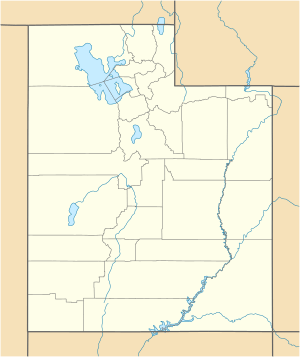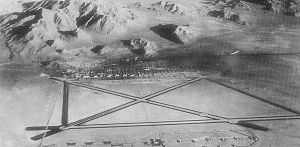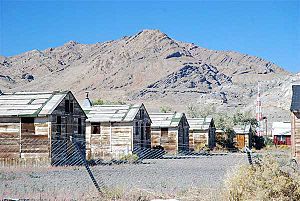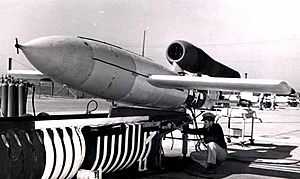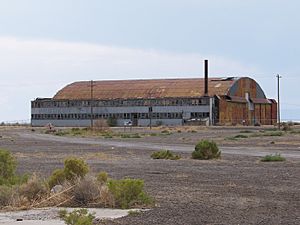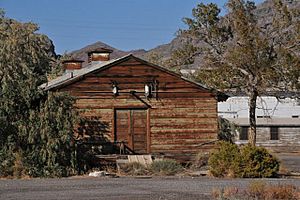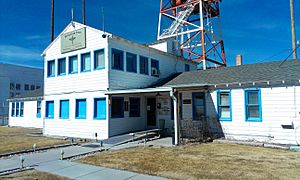Wendover Air Force Base facts for kids
Quick facts for kids Wendover Air Force Base
|
|
|---|---|
| Part of Second Air Force | |
| Located near: Wendover, Utah | |
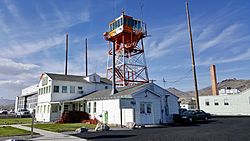
Tower and operations building
|
|
| Coordinates | 40°43′07″N 114°01′51″W / 40.71861°N 114.03083°W |
| Type | Army Airfield/Bombing Range/Test and Development |
| Site information | |
| Owner | Tooele County, Utah |
| Condition | Still in use |
| Site history | |
| Built | 1940–45 |
| In use | 1941–1965 |
|
Wendover Air Force Base
|
|
| Nearest city | Wendover, Utah |
| NRHP reference No. | 75001827 |
| Added to NRHP | 1 July 1975 |
Wendover Air Force Base is a historic place in Utah. It was once a very important United States Air Force base. Today, it is known as Wendover Airport.
During World War II, this base was a major training center. Crews learned to fly large B-17 and B-24 bomber planes here. Most famously, it was the secret training site for the 509th Composite Group. This special unit flew B-29 planes. They were the ones who carried out the atomic bombings of Hiroshima and Nagasaki at the end of the war.
After the war, Wendover was used for more training and testing. The Air Force closed it in 1969. In 1977, the base was given to Wendover City. Later, Tooele County, Utah took over in 1998. The county still runs the airfield as a public airport. Part of the old bombing range is now the Utah Test and Training Range. The Air Force still uses it for practice with live targets.
Contents
How Wendover Air Base Began
The story of Wendover Air Force Base started in 1940. The United States Army needed more places to practice bombing. The area near Wendover, Utah, was perfect. It had very few people living there. The weather was usually great for flying. The closest big city, Salt Lake City, was about 100 miles away.
Building the base began on September 20, 1940. The bombing range construction started on November 4, 1940. By July 1941, the base and its range covered a huge area. It was about 86 miles long and 18 to 36 miles wide. Ranchers were worried about losing their land. But the War Department moved forward with the project.
The first military group arrived on August 12, 1941. They came to build targets on the bombing range. To get water, a pipeline was built. It brought water from a spring on Pilot Peak (Nevada) to the base.
Wendover During World War II
When the United States joined World War II, Wendover Field became even more important. It was the Army Air Force's biggest bombing and gunnery range. In March 1942, Wendover Army Air Field officially opened. It also became a place for new weapon research. This included guided missiles and remotely controlled bombs.
The base grew very quickly. By late 1943, there were about 2,000 civilian workers. There were also 17,500 military people at Wendover. Construction continued for most of the war. They built three long paved runways. There were also taxiways, a large ramp, and seven hangars. By May 1945, the base had 668 buildings. This included a hospital, gym, swimming pool, and two movie theaters. There were also homes for married officers and civilians.
Training Heavy Bomber Crews
Wendover's main job was to train groups flying heavy bombers. Training for Boeing B-17 Flying Fortress and Consolidated B-24 Liberator groups started in April 1942. The 306th Flying Training Group was one of the first to arrive.
The training had three main parts. First, individual crew members learned their jobs. Second, the whole crew trained together. They practiced missions as a team. The third and final part was group training. All the crews practiced flying in formation and mock combat missions. Many bomber groups trained here before going overseas to fight.
The Secret 509th Composite Group
In June 1943, secret plans began for using atomic bombs. The Boeing B-29 Superfortress was chosen as the plane for this mission. It needed special changes to carry the new bombs. This secret project was called "Silverplate."
Major General Leslie R. Groves, Jr. led the Manhattan Project. This was the top-secret effort to build the atomic bomb. He and General Henry H. Arnold chose Lieutenant Colonel Paul Tibbets to lead the special bombing group. Tibbets was an expert B-29 pilot. He picked Wendover for the training because it was far away from cities. This helped keep the project a secret. It was also close enough to other important sites for testing. The base was given the code name "Kingman."
On September 14, 1944, the 393d Bomb Squadron arrived at Wendover. This squadron became part of the new 509th Composite Group. This group was designed to be very self-sufficient. It included many different units. These units helped with maintenance, transport, and security. A special Manhattan Project unit was also attached to the group.
A special unit, the 216th Army Air Forces Base Unit, built practice atomic weapons. These were models without nuclear material. They used them for drop tests. They needed to learn how the bombs would fly and how their parts would work. In February 1945, a Flight Test Section was created. They used five special B-29s for testing. They carried out many test drops in June and July. These tests used models of the "Little Boy" and "Fat Man" bombs.
The aircrews trained constantly until May. Each bombardier practiced dropping at least 50 inert "pumpkin bombs." These were practice bombs shaped like the real ones. Once Tibbets felt his group was ready, they moved. In May 1945, the group sailed to Tinian Island in the Pacific. From Tinian, they carried out the atomic bombings of Hiroshima and Nagasaki.
Testing the JB-2 Flying Bomb
In September 1944, a special team arrived at Wendover. They brought thirteen Republic-Ford JB-2 flying bombs. The JB-2 was an American copy of the German V-1 flying bomb. German V-1s had been found after crashing in England. American engineers studied them to make their own version.
At Wendover, they built a launch ramp for the JB-2. They also changed a B-17 bomber. This allowed it to carry and launch the jet bomb from under its wing. Many tests were done. The Army planned to make thousands of these bombs. They were meant to be used in the planned invasion of Japan. However, the war ended suddenly in September 1945. So, the JB-2 program was stopped. The weapon was never used in battle.
After the War
After World War II, Wendover Field continued some training. B-29s returning from the war were stored here. In 1946, a large fire destroyed a hangar and several buildings. Six training planes were also lost.
Wendover also played a role in developing new weapons after the war. They continued testing the JB-2 flying bomb. They also tested B-17 planes to fly remotely. New gliding bombs were being developed. These could be controlled by radar or radio. In 1946, the GAPA project had the first supersonic flight of an American Air Force vehicle.
In March 1947, many research programs moved from Wendover. About 1,200 people moved to New Mexico. They continued guided missile research there. Wendover Air Force Base was officially renamed in 1947. But much of the base remained unused. It was closed in 1948.
The base was reactivated in 1954 for training exercises. Millions of dollars were spent to fix up the facilities. But it was closed again in 1957. It was renamed Wendover Air Force Auxiliary Field. By 1962, only 128 of the original 668 buildings were left. Many had been removed or had burned down.
The base was reactivated again in 1961. But only a small firefighting team was stationed there. In 1972, the base was declared surplus. It was still sometimes used for training by Air National Guard units. The firefighting team stayed until 1977.
Wendover was listed on the National Register of Historic Places in 1975. In 1977, most of the base was given to the city of Wendover. This included the runways, hangars, and hospital. The Air Force kept a small part of the base.
From 1980 to 1986, Wendover was used for "Red Flag" exercises. These were large training events for fighter pilots. Over 9,000 military personnel came to Wendover for these exercises. The U.S. Air Force gave the rest of the base to Wendover in 1992.
Wendover Today
As of 2015, Wendover Air Force Base is used as a civil airport. It has unusually long runways for a small airport. The airfield is very isolated in northwest Utah. It sits in a vast, dry area. This isolation and dry climate have helped preserve much of the original airfield.
Many of the old facilities are still there today. This includes the large runways, taxiways, and most of the original hangars. The hangar where the Enola Gay B-29 was kept is still standing. Much of the hospital complex and many barracks remain. There is also an old cafeteria, chapel, and swimming pool.
In 2009, the "Manhattan Project's Enola Gay Hangar" was listed as an endangered historic site. A local group called "Historic Wendover Airfield" is working to save the old base.
Many movies, TV shows, and documentaries have been filmed at Wendover Field. Some famous ones include The Philadelphia Experiment (1984), Con Air (1997), Independence Day (1996), and Hulk (2003).
Images for kids


